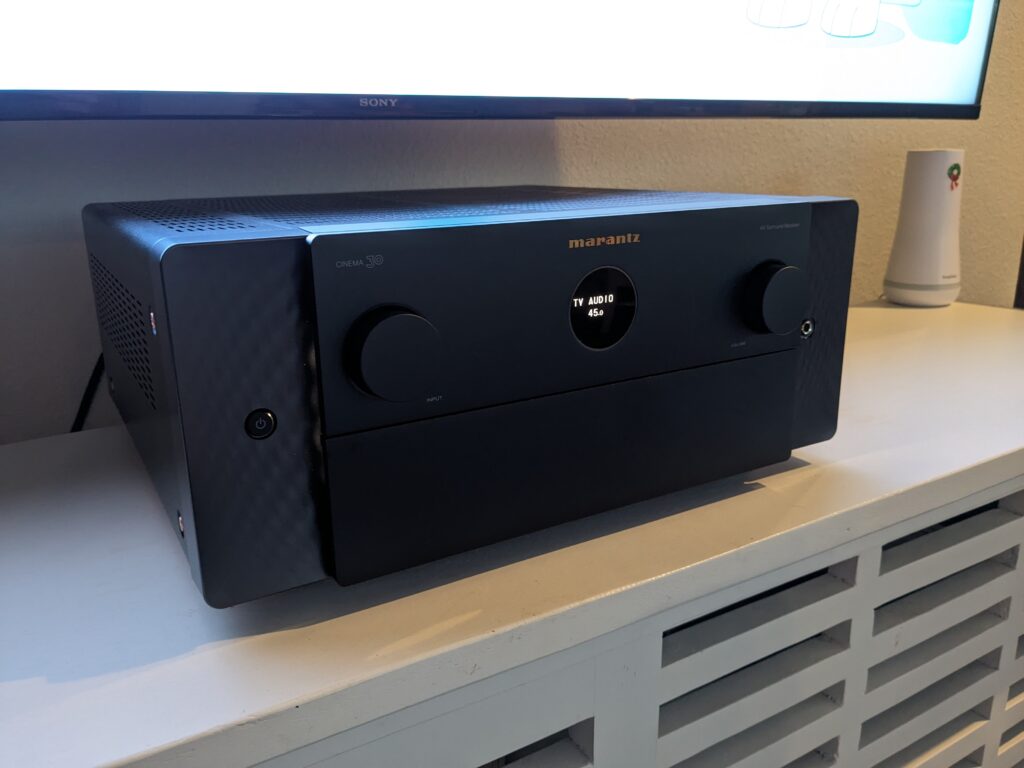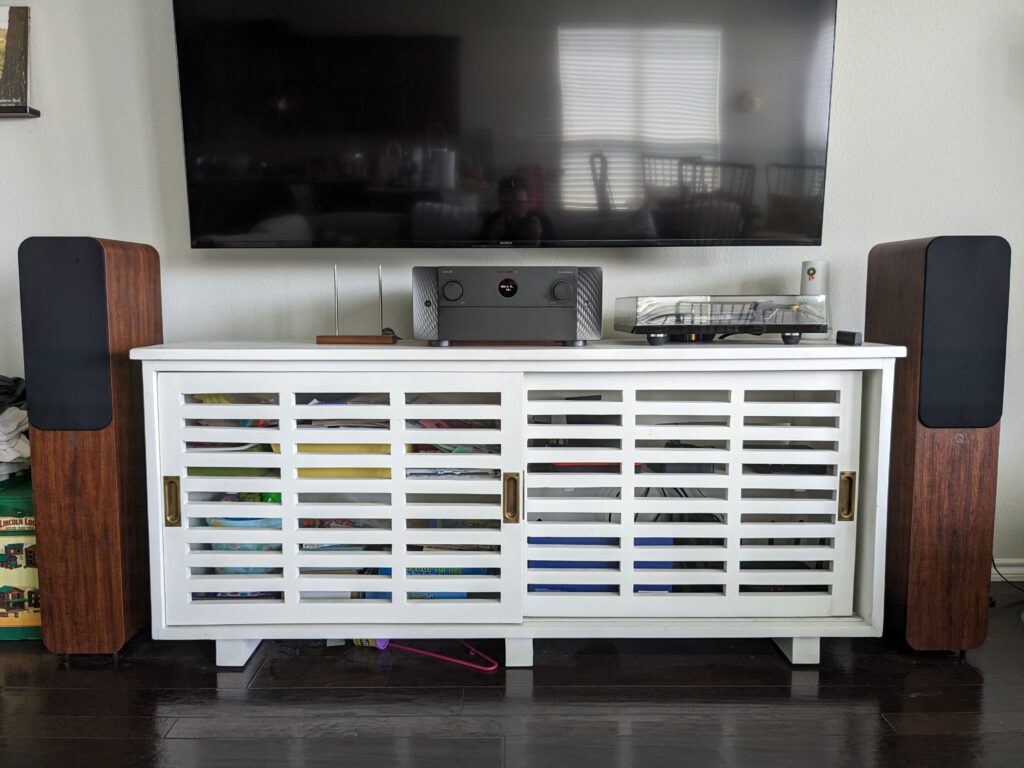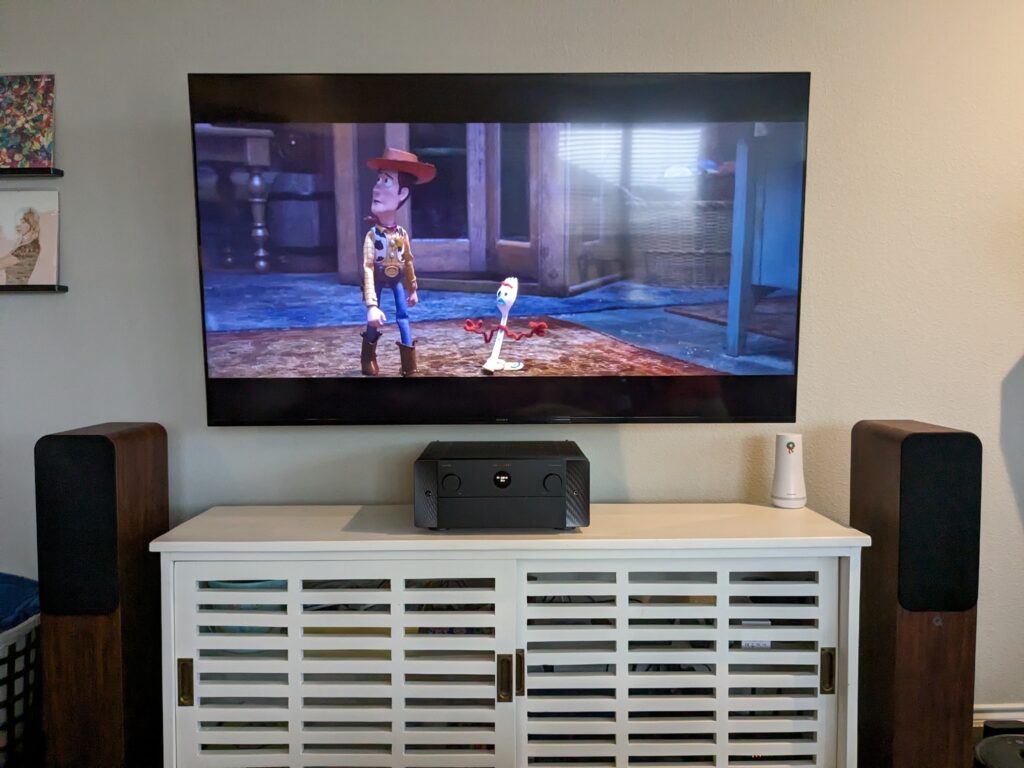If you had asked me a decade ago about my thoughts on Marantz receivers in the traditional stereo space, I would have laughed. Never did I think I’d be reviewing a Marantz receiver in the stereo electronics category.
But here I am. And yes, I was (and still am) quite surprised.
As a preface, my review here will be largely focused on the stereo aspects of the Cinema 30. I’ll touch on the multi-channel and video side, so don’t worry.
The Cinema Series

The Cinema series marks a return to reality in my mind for Marantz. The receivers themselves got a face-lift that is quite divisive. I personally enjoy its minimalist stature. With the front-bottom cover closed, there are only five things to talk about from left-to-right. In that order we have the power button, input selector, the “porthole”, volume knob, and headphone output.
That’s it.
It isn’t until you open up the bottom list that you get a full two line display along with additional buttons to affect zone2/3 operation, direct and puredirect, and a couple other useful functions.
As far as AV Receivers are concerned, the Cinema 30 sits atop the range. It shares a lot with the reference AV10 processor and in many ways is its equal when looking at pre-amp output. The only thing it doesn’t have is balanced out, which imo only really matters if the run from your processor to amplifier is more than 5-6 feet.
As you step down the range to the Cinema 40, 50, 60, etc…. you lose the toroid transformer, amp output, total channels, and lesser parts are used. The 30 is the only receiver in the range to use higher quality Sabre dacs, which I personally believe is largely responsible for gap in specifications between the 30 and 40.
Now, I haven’t heard the 40, so my assumptions here are just that. Once I get to hear the 40 in a controlled space compared to the 30, I’ll be more than happy to write again about my experiences between the two
A Receiver for Stereo?
Look, I get it. But it isn’t exactly uncommon. My wife set in place a requirement for something clean in our living room. That doesn’t necessarily preclude me from separates, but it does highlight the importance of overall aesthetics. Not that performance isn’t important. In my eyes, form follows function. But you know…. happy wife, happy life. Anyways!
If it weren’t for the fine fellows over at AudioScienceReview, I would have had a bit more trouble narrowing in on the right choice for a receiver. I don’t want to ruffle too many feathers, but no, I’m not a stout believer in measurements. Don’t get me wrong, I do enjoy their use as a starting place. It makes it easier for me to identify the traits I like in some speakers.
The System

It’s pretty simple this time around, consisting of only two components. Obviously, the component in question here is the Marantz Cinema 30. It is fulfilling the roles of network streamer, D/A converter, and integrated amplifier.
On the other end are the venerable Q Acoustics Concept 500 floorstanders. These have quickly become some of my favorite speakers for peeling back layers of music. I know, I know… open baffle speakers are all the rage these days. Maybe in a few years in a new house in a new room without kids. Just maybe.
By then though, I’ll be able to pull out my real reference Rega RS10’s.
Anyways, I will be using digital for the entirety of this review. Not that I couldn’t use the turntable, but I feel like most people interested in this receiver won’t be pairing it up with a turntable.
Music, Music, Music
Stepping back roughly a decade, I started with Azedia’s Life Goes On. I couldn’t tell you why, but this album has stuck with me throughout the years. No, it isn’t the greatest example of technical production, but it is always enjoyable to listen to and I know it like the back of my hand.
If you know Azedia, the opening track is probably the most well known. And…
This is just my opinion. I love the album, but I usually skip the second track. It isn’t bad, but it doesn’t fit the rest of the album.
“Honest” has always been a dark horse for me. As has been the case, the Cinema 30 does a good job overall. If I had to find a fault, it would be that I feel the absolute “grip” on the bass isn’t as well defined as my reference Osiris. But then again, that’s a dedicated stereo amp.
The next track “Absent” is great for getting a sense of the side-to-side soundstage, as well as checking for that pin-point soundstaging. Here’s where I find the first repeatable fault with the Cinema 30. I don’t want to sound crazy, but all variables equal (DB matched, etc), I can swear that the sound-stage feels wider and deeper with the Osiris. Even my decade old Rega Elicit mk3 does a better job here with soundstaging.
To those that pursue measurements above all else, I’ve probably lost your vote of confidence. But it’s hard to deny what I’m hearing. No, it isn’t a blind ABX, but I can close my eyes on this track and point to the edge of the soundstage. Every time the Cinema 30 is narrower. Not by much, but it’s there and it’s repeatable.

I’m going to gloss over the next couple of tracks. Not because they aren’t good, but so we can get on with other albums. “How Does It Make You Feel” is a love-it-or-hate-it track. I love it…. it’s an interesting choice in how the lyrics are sung. “Agony” brings things back to a bit of normalcy. The vocalist is clear and center-stage.
Keeping with older albums, I stepped even further back to listen to Andrew Bird’s “the Mysterious Production of Eggs”.
We kick things off with the opening track “Sovay”. It’s hard to deny the musicality of the Cinema 30. All while being a receiver! I’m still in shock at times. None of the wistfulness is lost on this track, though I do get the sense that it’s a bit more boring than I’m used to. Not sure if I’m imagining it though.
“A Nervous Tic Motion of the Head to the Left”. Ah yes, this is the Andrew Bird that I love. That mixing of instruments and the overall soundstaging. So, by this point, I was definitely able to conlude that I wasn’t imaging things with the side-to-side stage being narrower than I’m used to. I had my wife do the same with closing her eyes and pointing to where the “edge” of the sound was on the same track.
We ended up with similar results. How much narrower? Well, we sit roughly 10 feet from the speakers.
The next album I listened to was “Lessons” by Thrupence. I know what most of you are probably asking – “What by who?”. I get it. Not nearly as well known, but neither is Azedia I guess. I suppose I was just in that kind of mood.
What I love about this album is it really tests the – I hate myself for saying this – PRaT of a system. No vocals. And let’s be honest, when there aren’t vocals, your mind pays more attention to everything else because it has to! I’m not going to talk about individual tracks, instead about the overall experience. In my mind, the whole album should be experienced in a single sitting and as nothing else.
If I’m convinced of anything after listening to this album, it’s that the Cinema 30 has no real issues digging down deep where it counts. Does it compare to my reference amps? No, not really. But then again, I wouldn’t expect it to be, being a multi-channel amplifier that’s a third the cost of my reference.
Without going into too much detail, it isn’t the depth that fell short. The Cinema 30 was more than capable of driving my speakers as low as my reference Osiris or EL84M-FFX monoblocks. It was (again with this dumb PRaT) the “roundness” of the deepest notes that couldn’t compare. I still enjoyed it, but compared to higher class amplification it fell short.
To Pure Direct or Not To
So, the music section above was listened to largely in “auto” mode. The Marantz receivers also have a Direct and Pure Direct audio mode that will bypass any additional processing and turn off the front screens so that you, the listener, get the best listening quality as possible.
I did both sighted and unsighted tests between the two and I was hard pressed to consistently pick up the difference. On some tracks, like Azedia’s “Honest”, that soundstage was very obviously affected. Well, maybe not obviously to most people, but I could tell a difference. And it was consistent between sighted and unsighted.
That said
And now with more Video Content
Since it is a receiver, it’s only appropriate to add a section on the performance there and any oddities I noticed. In short, what I experienced in two-channel playback was largely reflected for video. Clear audio with an unchanged frequency response curve (from what I could year) compared to two-channel.

This makes sense, as it’s all going through the same D/A Converters.
One area I wasn’t entirely sure on was the 70% guarantee. I moved speakers downstairs so I could stress the amp section as much as possible, ending up with a 5.1.4 + 2.0 (Zone 2) configuration. I would have tried the media room where I have 7.2.4, but as the room is smaller it doesn’t take a ton of power to drive the room to reference levels. The living room downstairs is easily 3x in terms of size.
I cranked up zone 2, our outdoor speakers, and then put on Assassin’s Creed in 4k. Fairly quickly all my worries about having enough power faded away into just…. enjoying the movie. I started to think that there wasn’t anything the Cinema 30 couldn’t do.
Another quick tidbit I want to bring up are the internal fans on the Marantz. there are four of them, two for each bank of amplifiers. Under normal operation, I never saw them turn on. It wasn’t until the above scenario that I saw them turn on. But, it’d be impossible to hear them without having your ear right on the chassis. Surely, Marantz have their thermals under control. It’s safe to say these fans will last the lifespan of the unit.
In Conclusion
This is will probably be the most controversial thing I’ve said in this review. I know that Marantz claims to have a house sound that’s maybe on the warmer side of neutral. With this album, I did not necessarily find that to be the case. Nor with the Azedia one to be honest. To be honest, I think this is great overall. I don’t think receivers should have a house sound, instead being neutral and transparent (enough).
The fact that Marantz had to provide two different filter curves should tell you that the amp section itself is neutral. Don’t get me wrong, I have nothing against amplifiers that impart their own sound (in some fashion or another). That’s why I have a Rega Osiris and the Triode Lab EL84M-FFX monoblocks.
Anyways. To draw a general conclusion about the Cinema 30. I believe it is well worth its asking price. It never faltered while watching video content, and performed equally well in stereo. Only when actually listening for differences did I find it fell short compared to its dedicated brethren. But for 75% of people I don’t see this being an issue compared to all the other benefits you gain.
I’ll put it this way, I like it enough to be okay with running it full time in the living room. All of my dedicated stereo equipment now lives in my office or the media room.

